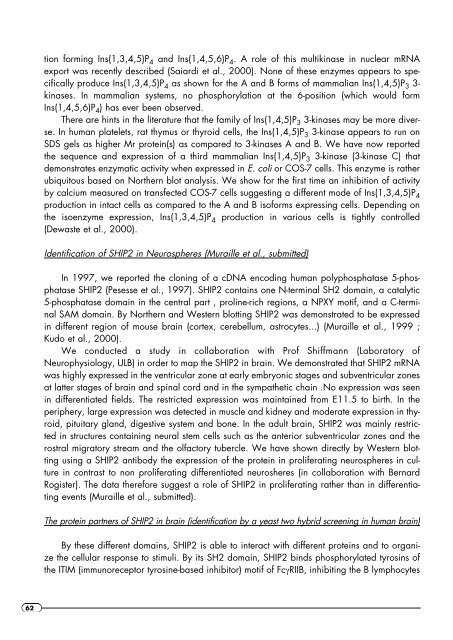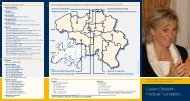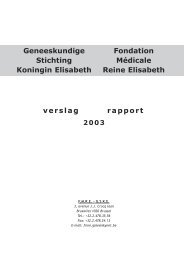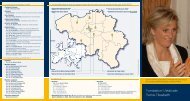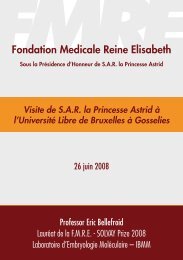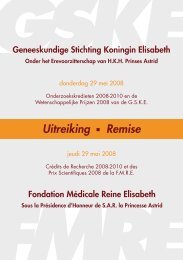Geneeskundige Stichting Koningin Elisabeth ... - GSKE - FMRE
Geneeskundige Stichting Koningin Elisabeth ... - GSKE - FMRE
Geneeskundige Stichting Koningin Elisabeth ... - GSKE - FMRE
Create successful ePaper yourself
Turn your PDF publications into a flip-book with our unique Google optimized e-Paper software.
62<br />
tion forming Ins(1,3,4,5)P 4 and Ins(1,4,5,6)P 4. A role of this multikinase in nuclear mRNA<br />
export was recently described (Saiardi et al., 2000). None of these enzymes appears to specifically<br />
produce Ins(1,3,4,5)P 4 as shown for the A and B forms of mammalian Ins(1,4,5)P 3 3kinases.<br />
In mammalian systems, no phosphorylation at the 6-position (which would form<br />
Ins(1,4,5,6)P 4) has ever been observed.<br />
There are hints in the literature that the family of Ins(1,4,5)P 3 3-kinases may be more diverse.<br />
In human platelets, rat thymus or thyroid cells, the Ins(1,4,5)P 3 3-kinase appears to run on<br />
SDS gels as higher Mr protein(s) as compared to 3-kinases A and B. We have now reported<br />
the sequence and expression of a third mammalian Ins(1,4,5)P 3 3-kinase (3-kinase C) that<br />
demonstrates enzymatic activity when expressed in E. coli or COS-7 cells. This enzyme is rather<br />
ubiquitous based on Northern blot analysis. We show for the first time an inhibition of activity<br />
by calcium measured on transfected COS-7 cells suggesting a different mode of Ins(1,3,4,5)P 4<br />
production in intact cells as compared to the A and B isoforms expressing cells. Depending on<br />
the isoenzyme expression, Ins(1,3,4,5)P 4 production in various cells is tightly controlled<br />
(Dewaste et al., 2000).<br />
Identification of SHIP2 in Neurospheres (Muraille et al., submitted)<br />
In 1997, we reported the cloning of a cDNA encoding human polyphosphatase 5-phosphatase<br />
SHIP2 (Pesesse et al., 1997). SHIP2 contains one N-terminal SH2 domain, a catalytic<br />
5-phosphatase domain in the central part , proline-rich regions, a NPXY motif, and a C-terminal<br />
SAM domain. By Northern and Western blotting SHIP2 was demonstrated to be expressed<br />
in different region of mouse brain (cortex, cerebellum, astrocytes...) (Muraille et al., 1999 ;<br />
Kudo et al., 2000).<br />
We conducted a study in collaboration with Prof Shiffmann (Laboratory of<br />
Neurophysiology, ULB) in order to map the SHIP2 in brain. We demonstrated that SHIP2 mRNA<br />
was highly expressed in the ventricular zone at early embryonic stages and subventricular zones<br />
at latter stages of brain and spinal cord and in the sympathetic chain .No expression was seen<br />
in differentiated fields. The restricted expression was maintained from E11.5 to birth. In the<br />
periphery, large expression was detected in muscle and kidney and moderate expression in thyroid,<br />
pituitary gland, digestive system and bone. In the adult brain, SHIP2 was mainly restricted<br />
in structures containing neural stem cells such as the anterior subventricular zones and the<br />
rostral migratory stream and the olfactory tubercle. We have shown directly by Western blotting<br />
using a SHIP2 antibody the expression of the protein in proliferating neurospheres in culture<br />
in contrast to non proliferating differentiated neurosheres (in collaboration with Bernard<br />
Rogister). The data therefore suggest a role of SHIP2 in proliferating rather than in differentiating<br />
events (Muraille et al., submitted).<br />
The protein partners of SHIP2 in brain (identification by a yeast two hybrid screening in human brain)<br />
By these different domains, SHIP2 is able to interact with different proteins and to organize<br />
the cellular response to stimuli. By its SH2 domain, SHIP2 binds phosphorylated tyrosins of<br />
the ITIM (immunoreceptor tyrosine-based inhibitor) motif of FcγRIIB, inhibiting the B lymphocytes


